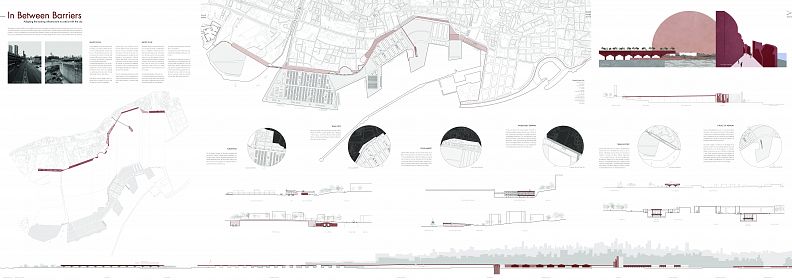In Between Barriers

Project idea
In the (re)design of the port infrastructure an attempt was made to rethink the limit of the coastline between the port and the city. This boundary becomes a linear structure that connects two levels and contains public/private systems, in order to transform the boundary infrastructure into a connective infrastructure.
The static linear elements in a city with several fractures and urban disconnections originate the concept of Linear Structures that Become Alive, where we considered as restraining infrastructure the «Charles Helou Road» and the «Nahr Beirut».
Nahr Beirut structure present itself as a barrier and a «non-place» in the city and new Railway Structure is proposed in order to give a new purpose to one of the static elements of this city. Reviving the memory of the river movement and also the memory of the Train as the main way of transporting products in Lebanon is the purpose for that intervention. While the Charles Helou Road is one of the main traffic points in the city and now receives the purpose of returning the pedestrian movement in what we consider to be one of the biggest obstacles that needs to be solved in the metropolis.
This way, the restraining infrastructure that creates barriers in the city emerges as the connecting infrastructure and linear structures create programs in between these limits.
Project description
The urban strategy for the proposal at the micro-scale level intends to subdivide the Port in two different moments, first one is industrial and entirely private and the other is administrative and with some public spaces, such as the memorial. In both of these moments the proposal is thinked as a solution at the limit that connects the port to the city. In this way, we propose some empty zones in the port to create opportunities for future expansions and new projects.
The industrial elements of the port are:
–Conventional cargo zone; containers terminal; scan; empty cargo zone; imported cars parking; warehouses; railway station; naval base and the new silos building.
The public and administrative side of the Port is composed by:
–Cruise terminal, souks market, free zone, administrative buildings and the new memorial.
Our approach for the linear structure is to create program in two different layers, the first one intends to extend the City in the upper level to the Port, while the second one search to expand the Port to the City in the lower level of the proposal. This way, the Linear Structure contains in the cruise terminal, the souks market, the train stop with the urban park and services zone.
Technical information
A Place of Memory - The new silo building is drawn in a way to create a direct connection with the memorial structure. While the place of memory aim to (re)think and (re)draw the ruin to preserve its magnitude, the new complex of the silos explore a delicate touch with the port to avoid the confront with the heigh of the pre-existing structure. This urban strategy is carried over to the design of an infrastructure that was once inhabited and that today has been turned into a ruin by the explosion. It is therefore sought to intervine in the ruin of the silos, transforming it from current boundary infrastructure that designs the urban landscape into a system capable of generating public space, through water as a key element. Design of a space capable of inhabiting the ruin, conserving and perpetuating the collective memory of the tragedy.
Train Factory - On the other side of the river, there is an element that connects the river to the fishermen’s marina, as an extension of the linear structure of the port. This piece is worked at two levels: Low level - Industry; High quota - city. As a model structure, it can accommodate several programs, adapting to the need through a modular structure. The landscaped roof aims to create an oasis within this industrial district. The Garden takes advantage of the height of this factory element to create a moment of contemplation for the city and the sea horizon.
Passengers Terminal - On the way down from Martyrs Square to the Port, a transforming object emerges along the way to the lowest level. The location was chosen in a strategic way due to its geographical relevance. The wall becomes a ramp that turns into stairs, which takes us to the lower level of the structure, where we can find the Terminal and the Free Zone. At the highest level this structure takes us to the top of the Cruise Terminal and places us at a privileged point in the relationship between the City and the Sea.
Souk Market - Charles Helou Garage is an iconic system in the city of Beirut. In the proposal, a structure that once had a role for car parking becomes a place for meeting, socializing and commerce. The main foundations of the building’s structure are reused and selected areas where the possibility of having a higher ceiling is viable create a wider and more spacious area to propose a new market.
Train Stop - Taking advantage of the natural slope between Charles Helou and the Port, a green garden area is designed at the city level, which marks the end of the Karantina district. At the lower level of the port, the line of the Container Train comes to the end.
Karantina - On the border between the Karantina neighborhood and the Port of Beirut, a subtle piece is designed, consisting of a thick wall that generates programs that are equally distributed across the urban fabric and the port network. This structure supports a canopy that allows a route and various activities on top.





